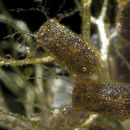Distribution
provided by eFloras
Old World tropics from India to Japan and Australia.
- license
- cc-by-nc-sa-3.0
- copyright
- Missouri Botanical Garden, 4344 Shaw Boulevard, St. Louis, MO, 63110 USA
Cyclicity
provided by Plants of Tibet
Flowering from June to November; fruiting from July to December.
Distribution
provided by Plants of Tibet
Utricularia aurea is occurring in Anhui, Fujian, Guangdong, Guangxi, Guizhou, Hainan, Hubei, Hunan, Jiangsu, Jiangxi, Taiwan, Yunnan, Zhejiang of China, Cambodia, India, Indonesia, Japan, Kashmir, Korea, Nepal, New Guinea, Pakistan, Sri Lanka, Thailand, Vietnam, Australia.
General Description
provided by Plants of Tibet
Perennials or annuals, suspended aquatic. Rhizoids usually present, verticillate at base or short above base of peduncle, fusiform, inflated, with filiform branches. Stolons filiform to relatively thick, branched. Traps on leaf segments, obliquely ovoid, 1-4 mm, stalked, mouth lateral or basal; appendages 2 or sometimes absent, dorsal, sparsely branched, setiform. Leaves numerous on stolons, 2-8 cm, divided from base into 3-4 semiverticillate primary segments; primary segments ovate to oblong-lanceolate in outline, 1.5-3 cm wide, pinnately divided into secondary segments; secondary segments dichotomously divided from base into numerous further segments; ultimate segments capillary, slightly flattened, laterally and apically setulose; stipulelike auricles usually present at base of primary segments, semicircular in outline, divided dichotomously into filiform sparsely setulose segments. Inflorescences erect, 5-25 cm, 3-10-flowered, glabrous; peduncle terete, 0.5-1.5 mm thick; scales absent; bracts basifixed, broadly ovate to orbicular, 1-2 mm, apex rounded. Pedicel dorsiventrally compressed, erect at anthesis, sharply deflexed and thickened in fruit, 0.4-2 cm; bracteoles absent. Calyx lobes subequal, ovate, apex rounded to subacute; lower lobe often slightly broader, 2-3 mm at anthesis, becoming fleshy, 7-9 mm, and spreading to reflexed in fruit. Corolla pale yellow, 1-1.5 cm, pubescent or glabrous; lower lip transversely elliptic, base with a prominent 2-lobed swelling, apex rounded to emarginate; spur cylindrical from a narrowly conical base, straight or slightly curved, as long as and parallel with lower lip, apex obtuse to subacute; palate pubescent; upper lip broadly ovate, apex rounded. Filaments curved, 1-1.5 mm; anther thecae confluent. Ovary ovoid. Style distinct; stigma lower lip semicircular, upper lip obsolete. Capsule globose, 4-5 mm in diameter, circumscissile; persistent style greatly enlarged and elongated, often equaling or exceeding capsule. Seeds prismatic, 1-2 mm wide, 5-6 angled, narrowly winged on all angles; seed coat with isodiametric obscure reticulations.
Genetics
provided by Plants of Tibet
The chromosomal number of Utricularia aurea is 2n = 80 (Tanaka and Uchiyama, 1988).
Habitat
provided by Plants of Tibet
Growing in pools, lakes, swamps, river backwaters and rice fields; 100-2700 m.
Utricularia aurea: Brief Summary
provided by wikipedia EN
Utricularia aurea, the golden bladderwort, is a medium- to large-sized suspended aquatic carnivorous plant that belongs to the genus Utricularia (family Lentibulariaceae). It is the most common and widespread suspended aquatic species in Asia. Its native distribution ranges from India to Japan and Australia.

Utricularia aurea in a rice paddy

Utricularia aurea and Ipomoea aquatica

Close-up of the flowers
- license
- cc-by-sa-3.0
- copyright
- Wikipedia authors and editors




